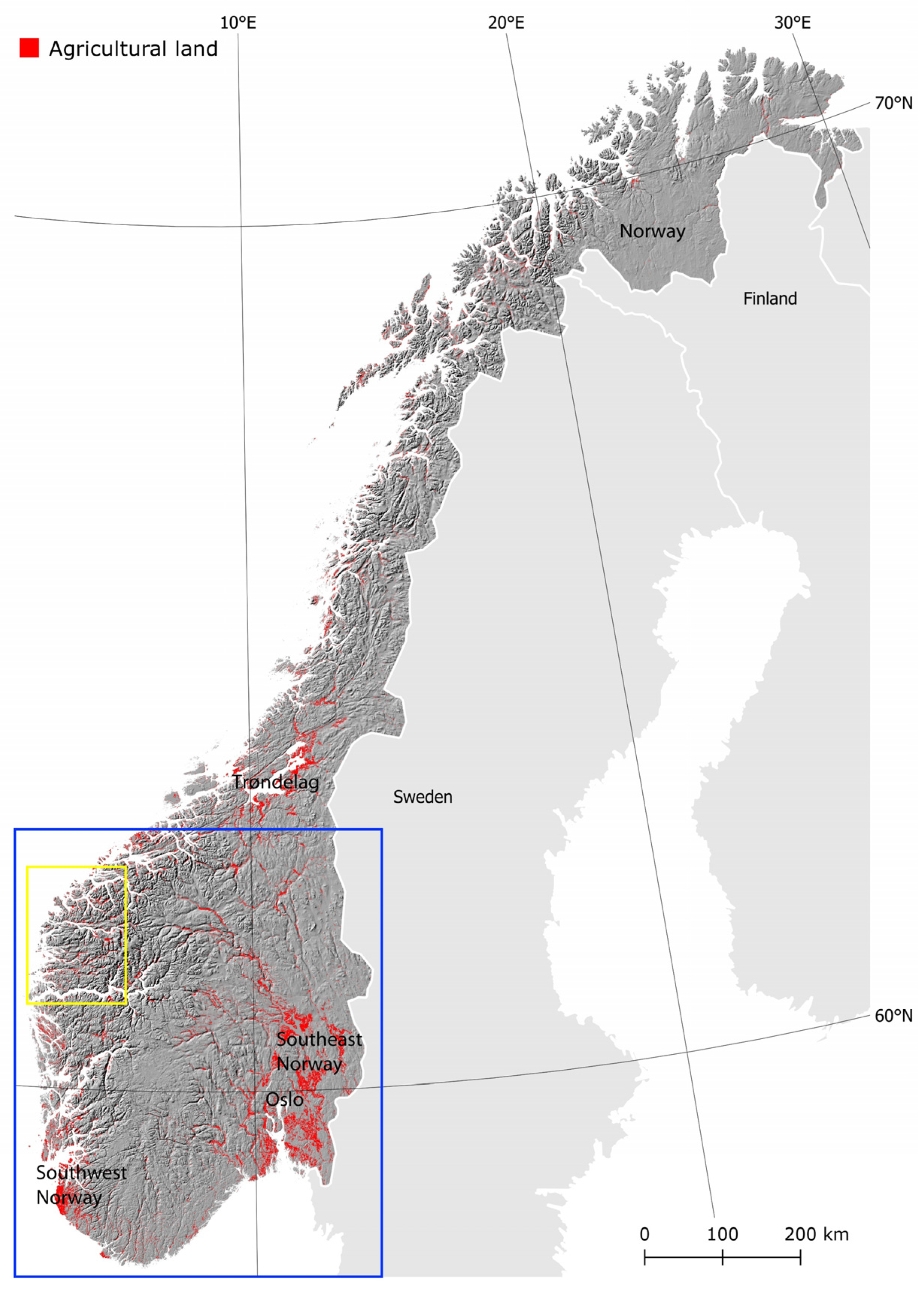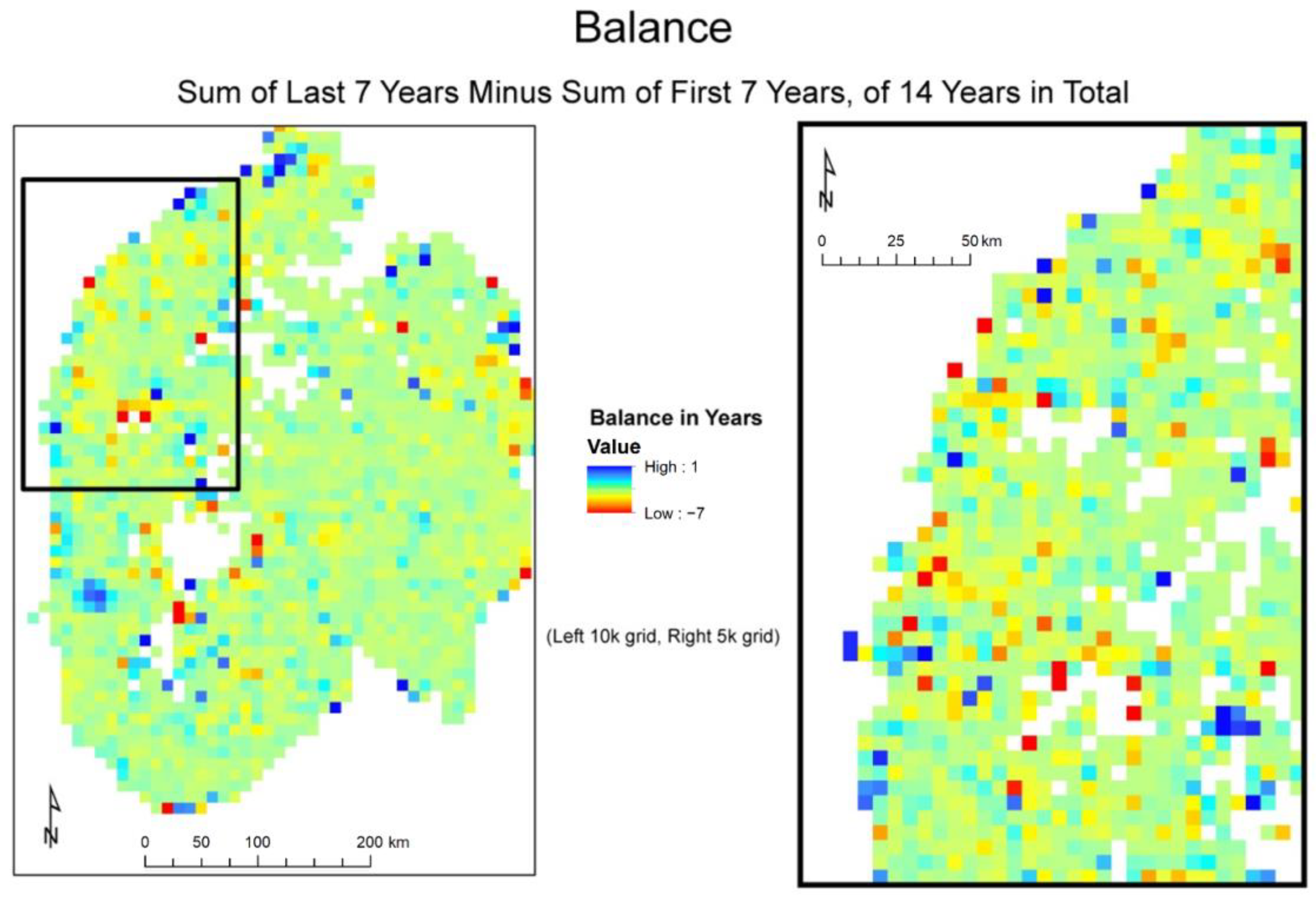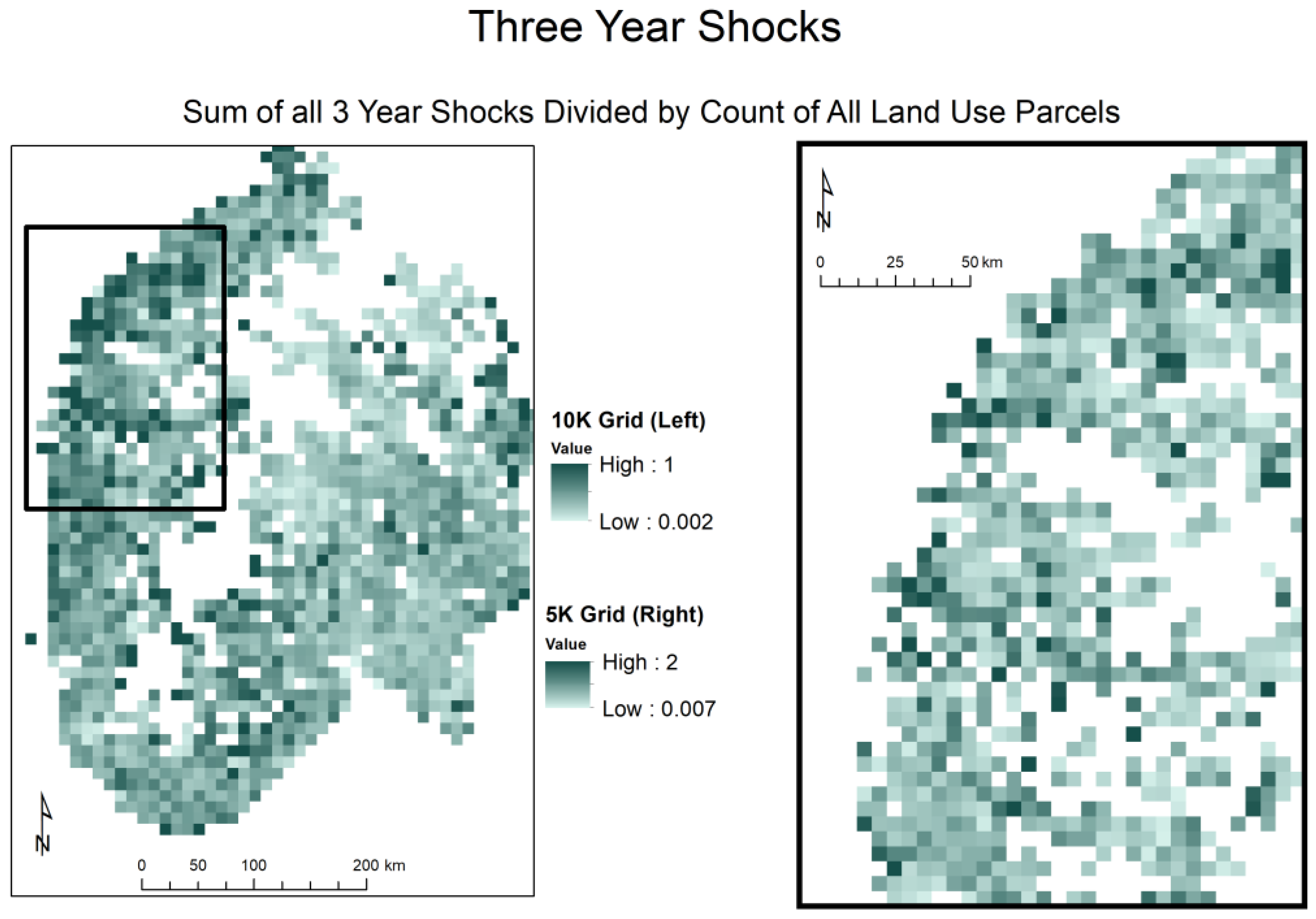Five Ways of Characterizing Agricultural Land Use Dynamics and Abandonment from Subsidy Data
Abstract
:1. Introduction
2. Materials and Methods
2.1. Study Area
2.2. The Norwegian Subsidy System
2.3. Data Preparation—Land Parcel ID Data
2.4. Analyses—Descriptive Abandonment Statistics
3. Results
3.1. Abandonment Metrics
3.2. Average
3.3. Balance
3.4. Three Year Shocks
3.5. Logistic Regression
3.6. Long-Term Outlook
4. Discussion
5. Conclusions
Author Contributions
Funding
Institutional Review Board Statement
Informed Consent Statement
Data Availability Statement
Conflicts of Interest
References
- Intergovernmental Panel on Climate Change—IPCC. Climate Change and Land. An IPCC Special Report on Climate Change, Desertification, Land Degradation, Sustainable Land Management, Food Security, and Greenhouse Gas Fluxes in Terrestrial Ecosystems; Summary for Policymakers; WHO: Genève, Switzerland; UNEP: Nairobi, Kenya, 2019. [Google Scholar]
- Albrecht, J.; Carrez, D.; Cunningham, P.; Daroda, L.; Mancia, R.; Mathé, L.; Achim Raschka, A.; Carus, M.; Piotrowski, S. The Knowledge Based Bio-Economy (KBBE) in Europe: Achievements and Challenges; Clever Consult Technical Report; Clever Consult BVBA: Meise, Belgium, 2010. [Google Scholar]
- Anand, M. Innovation and Sustainable Development: A Bioeconomic Perspective; Brief for Global Sustainable Development Report 2016; United Nations Division for Sustainable Development Goals: New York, NY, USA, 2016. [Google Scholar]
- Heimann, T. Bioeconomy and SDGs: Does the bioeconomy support the achievement of the SDGs? Earth’s Future 2019, 7, 43–57. [Google Scholar] [CrossRef] [Green Version]
- Foley, J.A.; Ramankutty, N.; Brauman, K.A.; Cassidy, E.S.; Gerber, J.S.; Johnston, M.; Mueller, N.D.; O’Connell, C.; Ray, D.K.; West, P.C.; et al. Solutions for a cultivated planet. Nature 2011, 478, 337–342. [Google Scholar] [CrossRef] [PubMed] [Green Version]
- Benayas, J.R.; Martins, A.; Nicolau, J.M.; Schulz, J.J. Abandonment of agricultural land: An overview of drivers and consequences. CAB Rev. 2007, 2, 1–14. [Google Scholar] [CrossRef] [Green Version]
- Meyfroidt, P.; Chowdhury, R.R.; de Bremond, A.; Ellis, E.C.; Erb, K.-H.; Filatova, T.; Garrett, R.D.; Grove, J.M.; Heinimann, A.; Kuemmerle, T.; et al. Middle-range theories of land system change. Glob. Environ. Chang. 2018, 53, 52–67. [Google Scholar] [CrossRef]
- Yin, H.; Brandao, A.; Buchner, J.; Helmers, D.; Iuliano, B.G.; Kimambo, N.E.; Lewinska, K.E.; Razenkova, E.; Rizayeva, A.; Rogova, N.; et al. Monitoring cropland abandonment with Landsat time series. Remote Sens. Environ. 2020, 246, 111873. [Google Scholar] [CrossRef]
- Anderson, E.; Mammides, C. Changes in land-cover within high nature value farmlands inside and outside Natura 2000 sites in Europa: A preliminary assessment. AMBIO 2020, 49, 1958–1971. [Google Scholar] [CrossRef]
- Aune, S.; Bryn, A.; Hovstad, K.A. Loss of semi-natural grassland in a boreal landscape: Impacts of agricultural intensification and abandonment. J. Land Use Sci. 2018, 13, 375–390. [Google Scholar] [CrossRef]
- Fuchs, R.; Verburg, P.H.; Clevers, J.G.P.W.; Herold, M. The potential of old maps and encyclopaedias for reconstructing historic European land cover/use change. Appl. Geogr. 2015, 59, 43–55. [Google Scholar] [CrossRef] [Green Version]
- Keenleyside, C.; Tucker, G.M. Farmland Abandonment in the EU: An Assessment of Trends and Prospects; Report for WWF Netherlands; Institute for European Environmental Policy: London, UK, 2010. [Google Scholar]
- Pointereau, P.; Coulon, F.; Girard, P.; Lambotte, M.; Stuczynski, T.; Sánchez Ortega, V.; Del Rio, A. Analysis of Farmland Abandonment and the Extent and Location of Agricultural Areas That Are Actually Abandoned or Are in Risk to be Abandoned; JRC Scientific and Technical Reports EUR 23411EN; Joint Research Centre: Ispra, Italy, 2008. [Google Scholar]
- Food and Agriculture Organization—FAO. The Role of Agriculture and Rural Development in Revitalizing Abandoned/Depopulated Areas; Food and Agriculture Organization of the United Nations: Rome, Italy, 2006. [Google Scholar]
- Hart, J.F. Loss and abandonment of cleared farm land in the eastern United States. Ann. Assoc. Am. Geogr. 1968, 58, 417–440. [Google Scholar] [CrossRef]
- Kuntz, K.; Beaudry, F.; Porter, K. Farmers’ perceptions of agricultural land abandonment in rural western New York State. Land 2018, 7, 128. [Google Scholar] [CrossRef] [Green Version]
- Osawa, T.; Kohyama, K.; Mitsuhashi, H. Multiple factors drive regional agricultural abandonment. Sci. Total Environ. 2016, 542, 478–483. [Google Scholar] [CrossRef] [PubMed]
- Yu, Z.; Lu, C. Historical cropland expansion and abandonment in the continental U.S. during 1850 to 2016. Glob. Ecol. Biogeogr. 2008, 27, 322–333. [Google Scholar] [CrossRef]
- Ceaușu, S.; Carver, S.; Verburg, P.H.; Kuechly, H.U.; Hölker, F.; Brotons, L.; Pereira, H.M. European Wilderness in a Time of Farmland Abandonment. In Rewilding European Landscapes; Pereira, H.M., Navarro, L.M., Eds.; Springer: Berlin/Heidelberg, Germany, 2015; pp. 25–46. [Google Scholar]
- Haddaway, N.R.; Styles, D.; Pullin, A.S. Environmental impacts of farm land abandonment in high altitude/mountain regions: A systematic map of the evidence. Environ. Evid. 2013, 2, 18. [Google Scholar] [CrossRef] [Green Version]
- Munroe, D.K.; van Berkel, D.B.; Verburg, P.H.; Olson, J.L. Alternative trajectories of land abandonment: Causes, consequences and research challenges. Curr. Opin. Environ. Sustain. 2013, 5, 471–476. [Google Scholar] [CrossRef]
- Terres, J.M.; Scacchiafichi, L.N.; Wania, A.; Ambar, M.; Anguiano, E.; Buckwell, A.; Coppola, A.; Gocht, A.; Källström, H.N.; Pointereau, P.; et al. Farmland abandonment in Europe: Identification of drivers and indicators, and development of a composite indicator of risk. Land Use Policy 2015, 49, 20–34. [Google Scholar] [CrossRef]
- Van der Zanden, E.H.; Verburg, P.H.; Schulp, C.J.E.; Verkerk, P.J. Trade-offs of European agricultural abandonment. Land Use Policy 2017, 62, 290–301. [Google Scholar] [CrossRef]
- Poore, J.A.C. Call for conservation: Abandoned pasture. Science 2016, 351, 132. [Google Scholar] [CrossRef] [PubMed]
- Asheim, L.J.; Thorvaldsen, P.; Rivedal, S. Policy measures to preserve Norwegian coastal and fjord landscapes in small-scale farming systems. Environ. Sci. Policy 2020, 104, 43–51. [Google Scholar] [CrossRef]
- Eurostat. Agri-Environmental Indicator—Risk of Land Abandonment; Statistics Explained; Eurostat: Luxembourg, 2013.
- Beilin, R.; Lindborg, R.; Stenseke, M.; Pereira, H.M.; Llausas, A.; Slatmo, E.; Cerqueira, Y.; Navarro, L.; Rodrigues, P.; Reichelt, N.; et al. Analysing how drivers of agricultural land abandonment affect biodiversity and cultural landscapes using case studies from Scandinavia, Iberia and Oceania. Land Use Policy 2014, 36, 60–72. [Google Scholar] [CrossRef]
- Bignal, E.; McCracken, D. The nature conservation value of European traditional farming systems. Environ. Rev. 2000, 8, 149–171. [Google Scholar] [CrossRef]
- Dover, J.W.; Rescia, A.; Fungarino, S.; Fairburn, J.; Carey, P.; Lunt, P.; Arnot, C.; Dennis, R.L.H.; Dover, C.J. Land-use, environment, and their impact on butterfly populations in a mountainous pastoral landscape: Species richness and family-level abundance. J. Insect Conserv. 2011, 15, 523–538. [Google Scholar] [CrossRef]
- Hunziker, M. The spontaneous reafforestation in abandoned agricultural lands—Perceptions and aesthetic assessment by locals and tourists. Landsc. Urban Plan. 1995, 31, 399–410. [Google Scholar] [CrossRef]
- García-Ruiz, J.; Lana-Renault, N. Hydrological and erosive consequences of farmland abandonment in Europe, with special reference to the Mediterranean region—A review. Agric. Ecosyst. Environ. 2011, 140, 317–338. [Google Scholar] [CrossRef]
- Flury, C.; Gotsch, N.; Rieder, P. Site-specific and regionally optimal direct payments for mountain agriculture. Land Use Policy 2005, 22, 207–214. [Google Scholar] [CrossRef]
- Food and Agriculture Organization—FAO. The Future of Food and Agriculture: Trends and Challenges; Food and Agriculture Organization of the United Nations: Rome, Italy, 2017. [Google Scholar]
- Porter, J.R.; Xie, L.; Challinor, A.J.; Cochrane, K.; Howden, S.M.; Iqbal, M.M.; Lobell, D.B.; Travasso, M.I. Food Security and Food Production Systems. In Climate Change 2014: Impacts, Adaptation, and Vulnerability. Part A: Global and Sectoral Aspects; Contribution of Working Group II to the Fifth Assessment Report of the Intergovernmental Panel on Climate Change; Field, C.B., Barros, V.R., Dokken, D.J., Mach, K.J., Mastrandrea, M.D., Bilir, T.E., Chatterjee, M., Ebi, K.L., Estrada, Y.O., Genova, R.C., et al., Eds.; Cambridge University Press: New York, NY, USA, 2014; pp. 485–533. [Google Scholar]
- Kent, C.; Pope, E.; Thompson, V.; Lewis, K.; Scaife, A.A.; Dunstone, N. Using climate model simulations to assess the current climate risk to maize production. Environ. Res. Lett. 2017, 12, 054012. [Google Scholar] [CrossRef]
- Lågbu, R.; Nygård, Å.; Svendgård-Stokke, S. Jordsmonnstatistikk i Norge; NIBIO Rapport 4; Norwegian Institute for Bioeconomy Research: Ås, Norway, 2018. [Google Scholar]
- Montanarella, L.; Pennock, D.; McKenzie, N. Status of the World’s Soil Resources; Technical Summary; Food and Agriculture Organization of the United Nations: Rome, Italy, 2015. [Google Scholar]
- Elde, S.; Kvalvik, I.; Nøstvold, B.H.; Rødbotten, R.; Dalmannsdottir, S.; Halland, H.; Uleberg, E.; Reykdal, Ó.; Árnason, J.; Pálsson, P.G.; et al. The Arctic as a Food Producing Region. Phase 1: Current Status in Five Arctic Countries; NOFIMA Report 10-2018; Nofima AS: Tromsø, Norway, 2018. [Google Scholar]
- Ju, J.; Masek, J.G. The vegetation greenness trend in Canada and US Alaska from 1984–2012 Landsat data. Remote Sens. Environ. 2016, 176, 1–16. [Google Scholar] [CrossRef]
- Bryn, A.; Potthoff, K. Elevational treeline and forest line dynamics in Norwegian mountain areas—A review. Landsc. Ecol. 2018, 33, 1225–1245. [Google Scholar] [CrossRef] [Green Version]
- Hofgaard, A.; Tømmervik, H.; Rees, G.; Hanssen, F. Latitudinal forest advance in northernmost Norway since the early 20th century. J. Biogeogr. 2013, 40, 938–949. [Google Scholar] [CrossRef]
- Schirpke, U.; Tscholl, S.; Tasser, E. Spatio-temporal changes in ecosystem service values: Effects of land-use changes from past to future (1860–2100). J. Environ. Manag. 2020, 272, 1110. [Google Scholar] [CrossRef] [PubMed]
- Celio, E.; Koellner, T.; Grêt-Regamey, A. Modeling land use decisions with Bayesian networks: Spatially explicit analysis of driving forces on land use change. Environ. Model. Softw. 2014, 52, 222–233. [Google Scholar] [CrossRef]
- Kolecka, N.; Kozak, J.; Kaim, D.; Dobosz, M.; Ostafin, K.; Ostapowicz, K.; Wężyk, P.; Price, B. Understanding farmland abandonment in the Polish Carpathians. Appl. Geogr. 2017, 88, 62–72. [Google Scholar] [CrossRef]
- Van Vliet, J.; de Groot, H.L.; Rietveld, P.; Verburg, P.H. Manifestations and underlying drivers of agricultural land use change in Europe. Landsc. Urban Plan. 2015, 133, 24–36. [Google Scholar] [CrossRef] [Green Version]
- Stokstad, G.; Puschmann, O. Jordbruk og Geografi. Jordbruksregioner og Jordbruksdrift i Norge; NIBIO Rapport 4; Norwegian Institute for Bioeconomy Research: Ås, Norway, 2018. [Google Scholar]
- Sang, N.; Dramstad, W.E.; Bryn, A. Regionality in Norwegian farmland abandonment: Inferences from production data. Appl. Geogr. 2014, 55, 238–247. [Google Scholar] [CrossRef]
- Levers, C.; Schneider, M.; Prishchepov, A.V.; Estel, S.; Kuemmerle, T. Spatial variation in determinants of agricultural land abandonment in Europe. Sci. Total Environ. 2018, 644, 95–111. [Google Scholar] [CrossRef]
- Dramstad, W.E.; Sang, N. Tenancy in Norwegian agriculture. Land Use Policy 2010, 27, 946–956. [Google Scholar] [CrossRef]
- Hamilton, N.D. The role of land tenure in the future of American agriculture. Drake J. Agric. Law 2017, 22, 349–358. [Google Scholar]
- Stokka, T.; Dramstad, W.E.; Potthoff, K. The use of rented farmland in an area of intensive agricultural production in Norway. Int. J. Agric. Sustain. 2018, 16, 243–254. [Google Scholar] [CrossRef]
- Joint Research Centre. Assessing the Risk of Farmland Abandonment in the EU; Report EUR 25783; Joint Research Centre: Ispra, Italy, 2013. [Google Scholar] [CrossRef]
- Corbelle, E.; Crecente, R. Land abandonment: Concept and consequences. Rev. Galega Econ. 2008, 17, 1–13. [Google Scholar]
- Almås, R.; Gjerdåker, B.; Lunden, K.; Myhre, B.; Øye, I. Norwegian Agricultural History; Tapir: Trondheim, Norway, 2004. [Google Scholar]
- Bryn, A.; Strand, G.-H.; Angeloff, M.; Rekdal, Y. Land cover in Norway based on an area frame survey of vegetation types. Nor. J. Geogr. 2018, 72, 131–145. [Google Scholar] [CrossRef]
- Statistics Norway. Available online: https://www.ssb.no/jord-skog-jakt-og-fiskeri/faktaside/jordbruk (accessed on 23 March 2021).
- Mittenzwei, K.; Britz, W. Analysing farm-specific payments for Norway using the Agrispace model. J. Agric. Econ. 2018, 69, 777–793. [Google Scholar] [CrossRef] [Green Version]
- Organisation for Economic Co-Operation and Development—OECD. Agricultural Policy Monitoring and Evaluation 2016; Organisation for Economic Co-Operation and Development: Paris, France, 2016. [Google Scholar] [CrossRef]
- Sang, N.; Birnie, R.V.; Geddes, A.; Bayfield, N.G.; Midgley, J.L.; Shucksmith, D.M.; Elston, D. Improving the rural data infrastructure: The problem of addressable spatial units in a rural context. Land Use Policy 2005, 22, 175–186. [Google Scholar] [CrossRef]







| Parcel ID Number | a2003 | a2004 | a2005 | a2006 | a2007 | a2008 | a2009 | aQ 2010 | aQ 2011 | aQ 2012 | a 2013 E | a 2014 E | a 2015 E | a 2016 E |
|---|---|---|---|---|---|---|---|---|---|---|---|---|---|---|
| XXXX | 1 | 1 | 1 | 1 | 1 | 0 | 0 | 0 | 0 | 0 | 0 | 0 | 0 | 0 |
| XXXX | 1 | 1 | 1 | 1 | 1 | 1 | 1 | 1 | 1 | 1 | 1 | 1 | 1 | 1 |
| XXXX | 0 | 0 | 0 | 0 | 0 | 1 | 1 | 1 | 1 | 1 | 1 | 1 | 1 | 1 |
| XXXX | 1 | 1 | 1 | 1 | 1 | 1 | 1 | 1 | 1 | 1 | 1 | 1 | 1 | 1 |
| XXXX | 0 | 0 | 0 | 0 | 0 | 0 | 0 | 0 | 0 | 0 | 0 | 0 | 0 | 0 |
| XXXX | 1 | 1 | 1 | 1 | 1 | 1 | 1 | 1 | 1 | 1 | 1 | 1 | 1 | 1 |
| XXXX | 1 | 1 | 1 | 1 | 1 | 1 | 1 | 1 | 1 | 1 | 1 | 1 | 1 | 1 |
| XXXX | 0 | 0 | 0 | 0 | 0 | 0 | 0 | 0 | 0 | 0 | 0 | 0 | 0 | 0 |
| XXXX | 0 | 0 | 0 | 0 | 0 | 0 | 0 | 0 | 0 | 0 | 0 | 0 | 0 | 0 |
| Type of Classification | Method |
|---|---|
| Average | The simple average between 0 and 1 for all years |
| Three Year Shocks | The number of periods of three years or more where no claim was made, followed by a recorded return to production or the end of the study period |
| Balance | The sum of the last seven years, minus the sum of the first seven years |
| Logistic Regression Line | Trend in likelihood of use as a logistic regression line fitted through the time series |
| Long-Term Outlook | The logistic regression line classification, with all those points for which a line could not be fitted classified to either 1 or 0 based on their majority state |
| Parcel ID Number | a2003 | a2004 | a2005 | … | a 2014 E | a 2015 E | a 2016 E | X1 Intercept | Coeff X1 |
|---|---|---|---|---|---|---|---|---|---|
| XXXX | 1 | 1 | 1 | … | 0 | 0 | 0 | 18.56606861 | −19.66468079 |
| XXXX | 1 | 1 | 1 | … | 1 | 1 | 1 | 25.56606935 | −9.93607391 |
| XXXX | 0 | 0 | 0 | … | 1 | 1 | 1 | −18.56606851 | −19.66468079 |
| XXXX | 1 | 1 | 1 | … | 1 | 1 | 1 | 25.56606935 | −9.936073912 |
| XXXX | 0 | 0 | 0 | … | 0 | 0 | 0 | −25.56606852 | −4.144585628 |
| XXXX | 1 | 1 | 1 | … | 1 | 1 | 1 | 25.56606935 | −9.936073912 |
| XXXX | 1 | 1 | 1 | … | 1 | 1 | 1 | 25.56606935 | −9.936073912 |
| XXXX | 0 | 0 | 0 | … | 0 | 0 | 0 | −25.56606852 | −4.144585628 |
| XXXX | 0 | 0 | 0 | … | 0 | 0 | 0 | −25.56606852 | −4.144585628 |
Publisher’s Note: MDPI stays neutral with regard to jurisdictional claims in published maps and institutional affiliations. |
© 2021 by the authors. Licensee MDPI, Basel, Switzerland. This article is an open access article distributed under the terms and conditions of the Creative Commons Attribution (CC BY) license (https://creativecommons.org/licenses/by/4.0/).
Share and Cite
Dramstad, W.E.; Sang, N.; Forsberg-Mathiesen, H.; Bryn, A. Five Ways of Characterizing Agricultural Land Use Dynamics and Abandonment from Subsidy Data. Land 2021, 10, 1136. https://doi.org/10.3390/land10111136
Dramstad WE, Sang N, Forsberg-Mathiesen H, Bryn A. Five Ways of Characterizing Agricultural Land Use Dynamics and Abandonment from Subsidy Data. Land. 2021; 10(11):1136. https://doi.org/10.3390/land10111136
Chicago/Turabian StyleDramstad, Wenche E., Neil Sang, Henrik Forsberg-Mathiesen, and Anders Bryn. 2021. "Five Ways of Characterizing Agricultural Land Use Dynamics and Abandonment from Subsidy Data" Land 10, no. 11: 1136. https://doi.org/10.3390/land10111136
APA StyleDramstad, W. E., Sang, N., Forsberg-Mathiesen, H., & Bryn, A. (2021). Five Ways of Characterizing Agricultural Land Use Dynamics and Abandonment from Subsidy Data. Land, 10(11), 1136. https://doi.org/10.3390/land10111136






